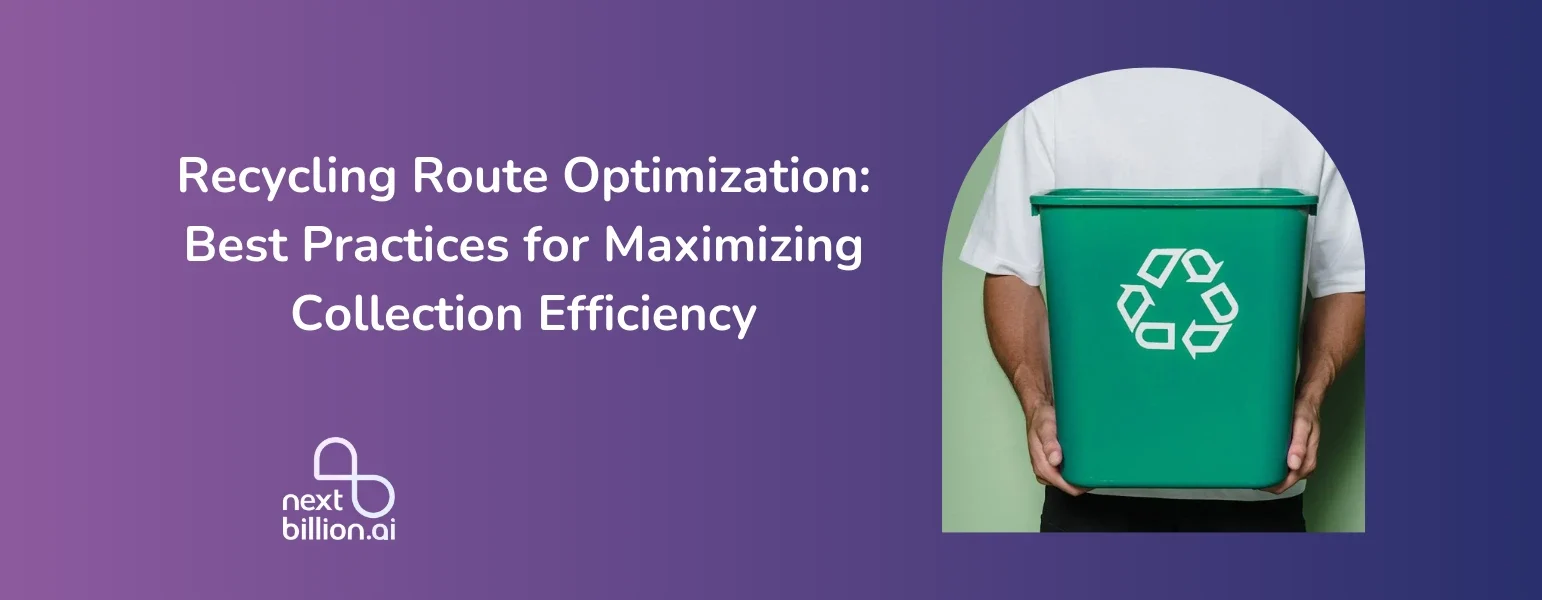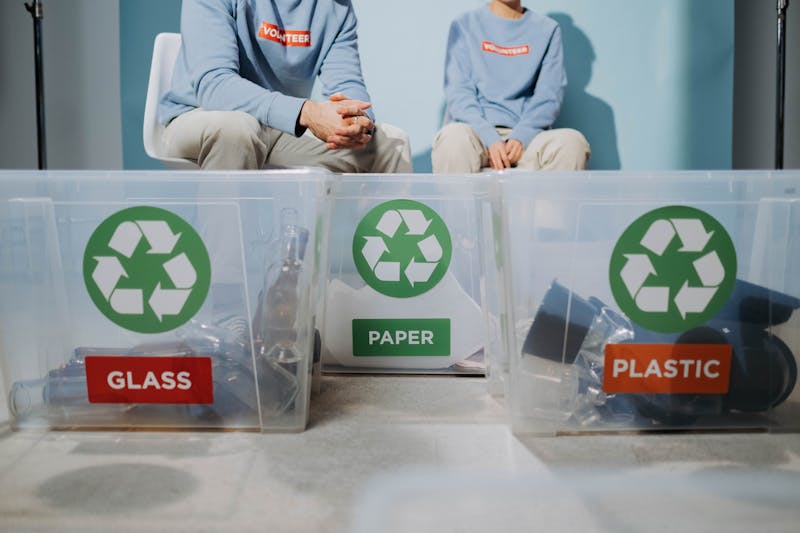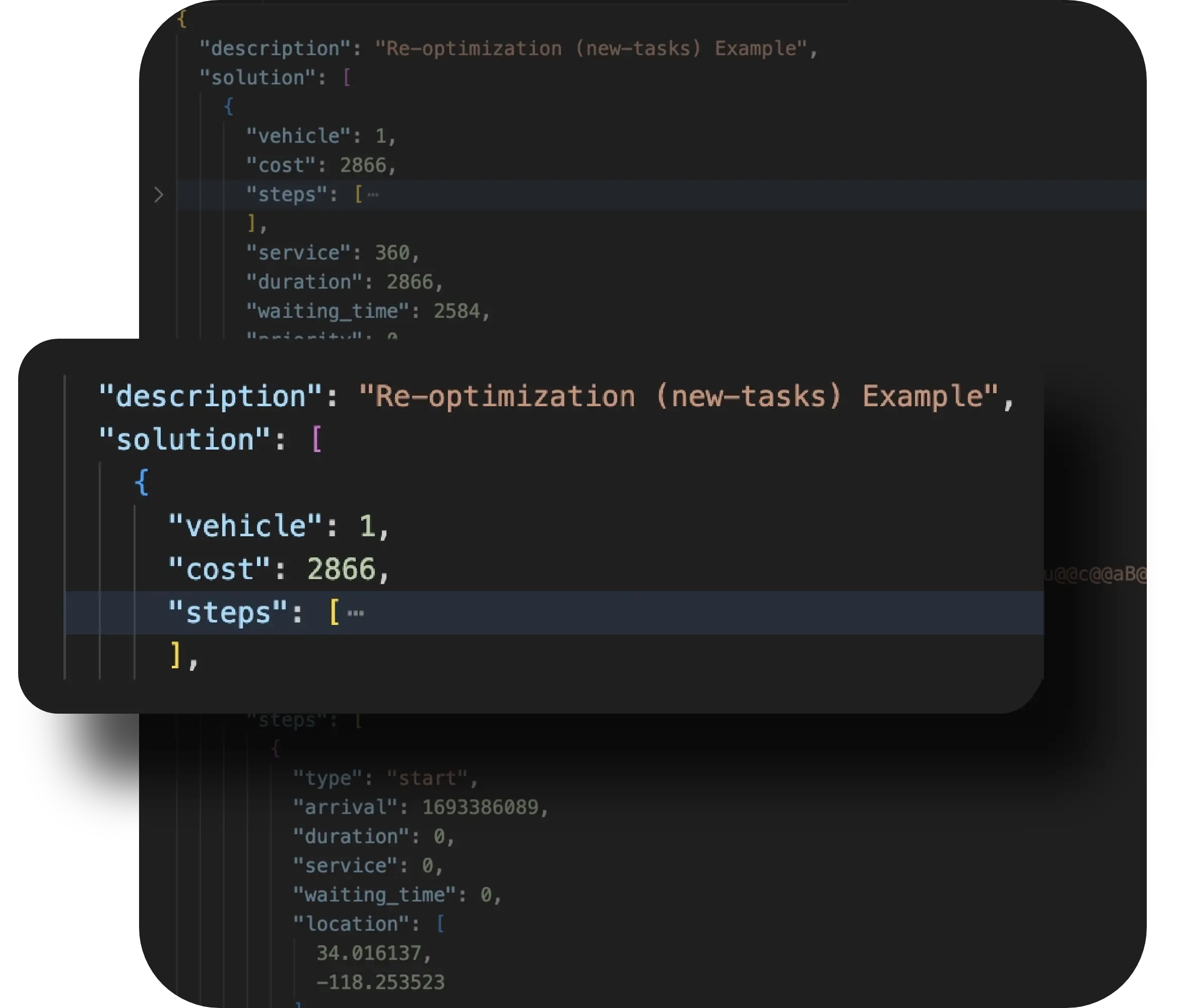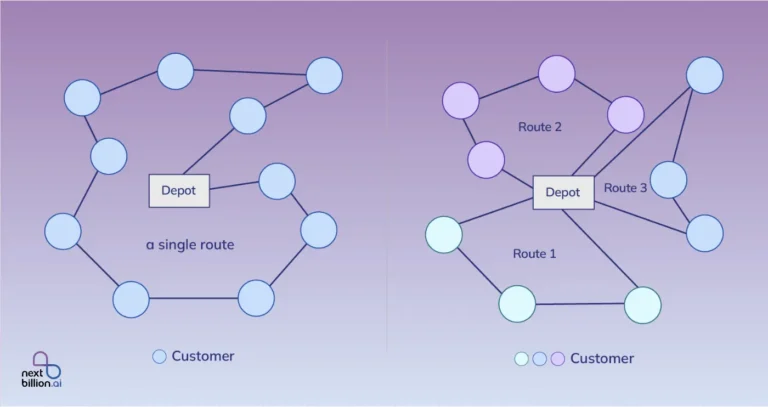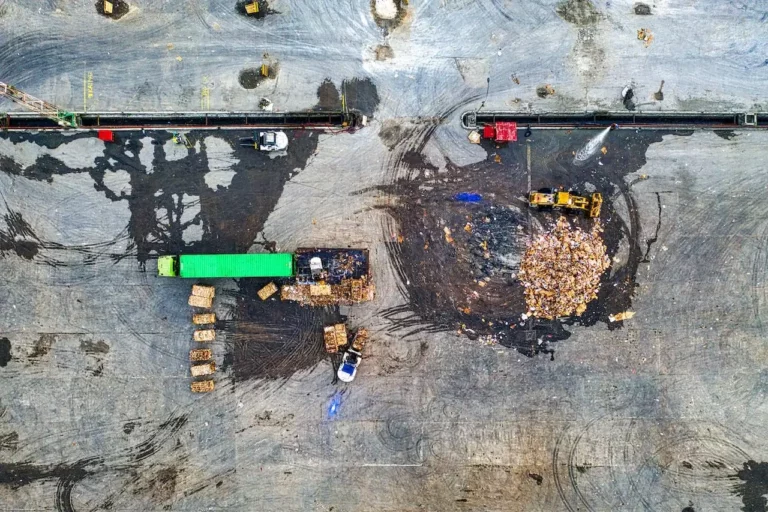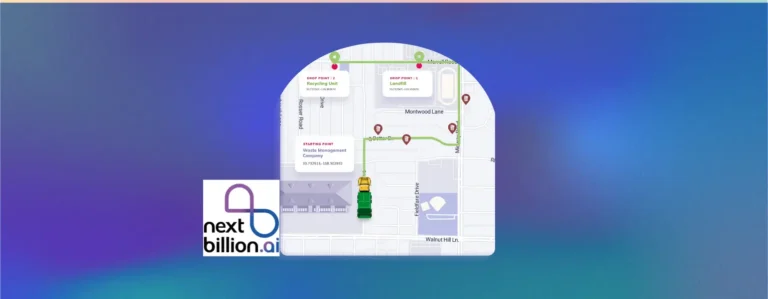
Table of Contents
One of the easiest things we can do to protect our environment is recycle. It is important for reducing waste and saving our resources. Have you ever thought about how recycling materials are collected? It requires a lot of planning and without a good plan, it can become inefficient and costly. Poorly planned routes may also lead to excessive fuel use, which wastes fuel, increases costs, and harms the environment.
This is where route optimization comes in. Recycling route optimization means planning and adjusting routes to make waste management more efficient. It uses technology such as AI, ML, IOT(Internet of Things and data analysis to find the best paths for trucks.
Recycling route optimization aims to reduce vehicle travel distances and save fuel and staff expenses. This will help minimize collection times and ensure that all recycling materials are picked up. Optimizing routes helps your waste management company improve service. Overall, it lowers costs and supports environmental sustainability.
NextBillion.ai offers robust and highly-reliable route optimization APIs and SDKs which can be integrated in your existing systems to provide cost-effective and streamlined routes. Let’s learn more about it and how you can implement in your operations to get optimized routes.
NextBillion.ai’s Route Optimization API
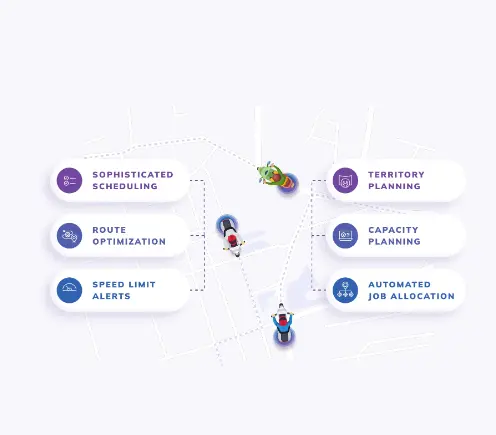
For every industry which requires management of fleet of trucks, it is essential to have an route optimization API integrated in your existing system to get optimized routes, so you can unlock numerous benefits. Optimized routes ensures most of the stops are covered in one trip and effective route is decided considering different factors, like real-time traffic and weather conditions, stops for performing prerequisites, and others.
Consider that you have one truck that needs to make 10 stops, the number of possible routes 3,628,800. Similarly, if you have five trucks in your fleet, then the possibilities of possible routes increases to 37,267,043,023,296,000. That’s why, it is better to have an route optimization at your disposal which computes the best route after considering different factors and by narrowing down the options.
NextBillion.ai provides a tailored, complete package for waste management field workforce team, which includes all important APIs and SDKs aimed to make collection more efficient, simpler, and cost-effective. This field workface plan includes route optimization API, navigation SDK, clustering API, and Distance Matrix API.
Now, when it comes to route optimization API, NextBillion offers an AI-powered API which can generate dispatch-ready routes within seconds after considering 50+ factors (hard and soft constraints). With this, you can build logical routes which includes time allocated for completing prerequisites duties, like tools pick-up, refuelling, or stopping at nearby vendor facility for discussion.
Besides, you can integrate a new stop in the existing route without any drastic changes in the existing route and maintaining the cost-effectiveness.
How to Implement NextBillion.ai’s AI-powered routing optimization?
Consider that you are a recycling collection and management company with collects recyclable waste or products from 200 points across the eight prominent areas of the city. Your team collects the recycled waste for 5 hours, and each truck has a capacity of 100 cubic meters. Now, here’s how our route optimization API can help you out:
Step 1. Enter all the Parameters
You will have to gather all the information, like vehicles, depot number, number of recycle bins, shift duration, and shift time. Now, the API will create non-intersecting polygons to divide the city area into different regions to pick up recycle materials. If necessary, you can segregate the highlighted regions based on their priority numbers.
Step 2. Trucks Assignment
You will have to allocate the trucks according to your requirements. For instance, each truck has a capacity of 100 cubic meters, and the capacity of the water collection bins is 20 meters. For each region, a set of trucks (probably five) can be assigned to cover most of the locations.
Step 3. Route Optimization
Given the number of trucks on the road, route optimization will suggest the best, tailored, and aligned routes to cover most of the stops in the same route with a dedicated time slot for refuelling, break rooms, and others.
Some trucks will be assigned a route, and some will not. By keeping the number of trucks on the road minimum, managers can ensure cost-effective and efficient operations. The route optimization API can be integrated with other modules, like the distance and matrix API, which provides the estimated time of arrival and calculates the distance between vehicles and recycle collection points. Overall, all the APIs are designed to enhance the driver’s experience.
Step 4. Reoptimization of Unassigned Tasks
Once the trucks return from their journey of collecting the recyclable elements and dropping them off to the service provider, they return to their depot. If some points remain unassigned, the route optimization API is rerun to assign the remaining tasks to ensure the same efficiency.
That’s it! With NextBillion.ai’s Route Optimization API is easy to integrate into your existing system. Your developers do not need to start from scratch, and all they need to do is consolidate your software services and route optimization APIs into one. You can schedule a demo today to see the route optimization API in action.
Benefits of Using Route Optimization in Recycling Operations
Recycling route optimization can help businesses achieve an effective recycling program. This can help reduce operational costs and increase the productivity of your employees. Here are some of the key benefits of recycling route optimization
1. Lower Collection Costs
Optimizing recycling routes helps save money. AI-powered algorithms can perform this optimization. By planning shorter routes, trucks use less fuel, cutting fuel expenses. Fewer drivers and trucks are needed, reducing overall costs. This also means less vehicle maintenance cost.
Optimized routes help ensure that pickups are done on time, making the service more reliable. When clients know their waste will be collected on schedule, they are happier. There are also fewer complaints about missed pickups.
2. Increased Efficiency
Well-planned routes make collection faster. Trucks spend less time driving, so they can complete more pickups in a day, which also boosts productivity. The team can finish their work more quickly and cover more areas. Shorter routes mean fewer emissions from trucks, which lowers air pollution and greenhouse gases. It also makes the recycling process more eco-friendly and supports sustainability efforts.
3. Improved Customer Communication
With route optimization tools, you can improve the communication of your entire team. That means you can easily connect with your clients and stakeholders with real-time access to data. Real-time tracking allows clients to see when trucks will arrive. Also, automated messages let them know when their waste will be picked up, reducing confusion and questions.
4. Better Resource Management
Optimizing routes helps companies use their trucks and staff more efficiently. Trucks can carry more recyclables and be used to their full capacity. Staff can focus on other tasks, and there is less downtime, which leads to better use of resources overall.
Route optimization software helps analyze data like traffic and collection times. This helps planners find the most efficient routes. It also helps spot busy areas or times when more collections are needed.
5. Increased Safety
Optimized routes help reduce the risk of accidents. By avoiding high-traffic areas or dangerous weather conditions, drivers stay safer. Adjusting routes based on weather also helps ensure safe and efficient collections, protecting both drivers and the community.
Best Practices for Maximizing Collection Efficiency
Now, let us have a look at some best practices for optimizing recycling routes. These practices maximize collection efficiency and reduce operational costs.
1. Plan Efficient Routes
You can start by carefully planning routes. For this, use mapping tools to find the best paths. Shorter routes save time and fuel. Aim to reduce travel distance between stops as this can lower costs and improve service.
For instance, imagine a recycling truck usually takes a route that includes 10 stops, covering 40 miles in total. By optimizing the route, the truck can reduce the distance to 30 miles while still visiting all 10 stops. This means 10 miles can be saved per trip. If the truck operates five days a week, that totals 50 miles saved weekly (10 miles saved × 5 trips).
This equals 200 miles saved over a month (50 miles × 4 weeks). If the truck averages 5 miles per gallon and fuel costs $4 per gallon, that saves 40 gallons of fuel for the month. At $4 per gallon, that results in $160 saved in fuel costs.
2. Group Similar Materials
Collect similar materials together. Grouping recyclables like paper, plastics, and metals can streamline the process. Trucks can be loaded more efficiently when similar items are together. This reduces the time spent for sorting materials at the facility.
Suppose sorting mixed materials takes an hour, and grouping items saves 20 minutes. That’s 40 minutes saved for each truckload. If the team collects 10 truckloads a week, that’s a total of 400 minutes saved each month (40 minutes saved × 10 truckloads).
Over a month, that’s about 6.67 hours saved (400 minutes ÷ 60). If the average hourly labor cost is $20, that’s a saving of $133.40 in labor costs.
3. Use Technology and Data
Use technology to improve operations. Apps and software can help optimize routes. Analyze data to find patterns in collections. This helps identify busy areas and peak times for better planning.
If the new software reduces route time from 90 minutes to 70 minutes, that saves 20 minutes per trip. If the team completes 12 trips a week, they save 240 minutes weekly (20 minutes × 12 trips). That totals 960 minutes saved over a month, or 16 hours (960 minutes ÷ 60). At $20 per hour, that’s $320.
4. Monitor Collection Times
Track collection times closely. Use GPS to find out how long each route takes. Look for any delays or problems. This information can help improve routes for better efficiency in the future. If a route usually takes 2 hours and shows delays, adjustments can cut it to 1.5 hours. That saves 30 minutes per trip. If this happens five days a week, it saves 2.5 hours weekly.
Over a month that totals 10 hours saved (2.5 hours × 4 weeks). At a labor cost of $20 per hour, that saves $200 in labor costs.
5. Adjust for Changing Weather Conditions
Weather can impact collection efficiency. Rain, snow, and ice can slow down trucks. Have a plan to change routes based on weather forecasts. Safety is important, so it’s sometimes best to delay pickups.
If bad weather delays routes by an hour each day, that’s 5 hours lost weekly (1 hour × 5 days). Over a month, that totals 20 hours lost (5 hours × 4 weeks). If each hour costs $20 in labor, that results in a loss of $400 in labor costs for the month.
6. Train Collection Staff
Training is important for success. Make sure staff understands best practices for collection. Teach them how to handle materials safely and efficiently. Well-trained staff can improve the recycling program’s overall effectiveness.
If training reduces accidents from 5 to 2 per month, that’s 3 fewer incidents. Each incident might cost $100 in repairs and lost time. Over a month that saves $300 in accident-related costs (3 incidents × $100). This makes the program safer and more efficient.
7. Balance Workloads Among Collection Vehicles
Make sure all collection vehicles have balanced workloads. This prevents some trucks from being overloaded while others are underused. A balanced system promotes efficiency and reduces vehicle wear and tear.
If three trucks collect waste and one truck does 50% more work, that truck may need more repairs. Adjusting the loads so each truck has equal work can save costs. This can cut maintenance costs by 20% monthly if one truck costs an extra $100 in repairs, that saves $200 a month for the fleet.
8. Incorporate Smart Bins and IoT Technology
Using smart bins with IoT technology helps monitor waste levels in real-time. This technology shows when bins are full and need to be emptied. It optimizes collection schedules and cuts down on unnecessary trips.
If a smart bin alerts the team when it’s 80% full, they can empty it before it overflows. This prevents missed collections and improves service. If this technology reduces unnecessary trips by 30% each month, it can save $72 in fuel costs. This is based on each unnecessary trip costing $24.
Key Factors Influencing Recycling Route Efficiency
Recycling plays an important part in waste management for businesses. However, many factors, such as area coverage, type of materials, and collection frequency, need to be considered. Below are some of the key factors influencing recycling route efficiency.
1. Population Density and Area Coverage
Recycling routes are easier in areas with many people. In these places, more recyclables are collected in a small space. Hence it requires shorter routes and also cuts down travel time. On the other hand, in areas with fewer people, you have to cover more distance. This makes travel longer and uses more fuel.
Try to focus on urban areas for recycling programs. You can organize awareness programs to encourage recycling in different areas. For rural areas, you can combine routes. Also, try to schedule pickups to make them more efficient.
2. Distance Between Stops
The distance between recycling stops plays a big role in efficiency. If recycling trucks travel long distances, they take more time and use more fuel. Conversely, shorter distances allow trucks to pick up materials faster and reduce costs.
Plan routes to minimize the distance between stops. For this, you can use route optimization software. These tools analyze patterns and give the best routes. You can also adjust routes based on the demand. This can reduce travel time and save on fuel costs.
3. Type and Volume of Recyclable Materials
The volume of different materials, including paper, glass, and plastics, affects how much can be collected in one trip. Also, the weight of the materials can affect your trip number. For example, Bulky materials may need to be emptied more, which can make the routes longer.
You should try to sort materials at the source. You can also encourage residents to separate items properly, which can reduce the amount of mixed material and make routes more efficient.
4. Amount of Waste
Not only the type, but also the amount of waste collected affects efficiency. In simple words, more waste means more trips and longer routes. Analyze waste generation trends and schedule pickups based on expected waste amounts. This ensures resources are used efficiently and reduces unnecessary trips.
5. Weather Conditions
Weather can greatly affect recycling routes. Rain, snow, or ice can slow down trucks and make roads dangerous. Recycling companies need to monitor the weather and adjust their routes. They may have to delay pickups during bad weather to ensure safety and efficiency.
Use a weather monitoring system. Adjust routes based on forecasts to avoid dangerous conditions. Consider rescheduling pickups during severe weather to ensure the safety of your employees.
6. Collection Frequency and Scheduling
Efficiency relies on how often pickups occur. If pickups are irregular, bins can overflow, and residents get frustrated. But if pickups happen too often, it wastes resources, and vehicles are not fully used. Scheduling routes to avoid traffic and match busy times helps use resources better.
Set a regular collection schedule. You can also use data analytics to find the best pickup times. Adjust schedules to match traffic patterns and community needs. This will help you use resources more effectively
Optimizing recycling collection routes is very important for waste management companies. It helps save money by reducing fuel and labor costs and also improves service quality and cleanliness. Shorter routes cut down on pollution, which is better for the environment and makes driving safer.
NextBillion.ai’s Dynamic Route Optimization provides real-time traffic data, helping businesses change routes quickly. The technology keeps operations running smoothly as companies grow. It also offers easy-to-use tools and helpful data for ongoing improvements. These strategies will make recycling collection more efficient and eco-friendly, helping create a cleaner and healthier planet for everyone.
About Author
Rishabh Singh
Rishabh Singh is a Freelance Technical Writer at NextBillion.ai. He specializes in Programming, Data analytics and technical consulting, turning complex tech into clear and engaging content.





